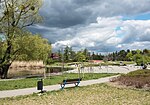St. John Climacus's Orthodox Church, Warsaw

The St. John Climacus's Orthodox Church (Polish: Cerkiew św. Jana Klimaka, Russian: Церковь Святого Иоанна Лествичника) in Warsaw is an Orthodox parish church belonging to the Warsaw deanery of the diocese of Warsaw-Bielsk within the Polish Orthodox Church. The church is located at 140 Wolska Street in the Ulrychów area of Wola district, inside the Orthodox cemetery. It was built from 1903 to 1905 at the initiative of the Archbishop of Warsaw Hieronymus (Ilya Tikhonovich Ekzemplarskii) as a burial place for his son Ivan and for the future the church hierarchy as well as serving as a church for cemetery funerals and church services for the deceased. The Orthodox parish became associated with Russian rule during the interwar period where many Orthodox churches were demolished or closed. Except for the period between 1915 and 1919, the church continued services almost uninterrupted. It was damaged during World War II, and during the Wola massacre the Germans murdered its priests, their families and the children from the Orthodox orphanage run by the parish. The building was designed by Vladimir Pokrovsky. It mimics the appearance of 17th century church buildings in Rostov. The church contains historic icons and items from the early 20th century, including an iconostasis made by Alexandr Murashko. Murals added in the 60s and 70s are by Adam Stalony-Dobrzański and Jerzy Nowosielski. The building was renovated from 1945 to 1948 and in the 60s and 70s. Since 2003, relics of St. Bazyli Martysz in the church have been made available to worship. The church, along with the whole area of the Wola Redoubt, was entered in the register of monuments on August 20, 2003 (No. A-54).
Excerpt from the Wikipedia article St. John Climacus's Orthodox Church, Warsaw (License: CC BY-SA 3.0, Authors, Images).St. John Climacus's Orthodox Church, Warsaw
Wolska, Warsaw Wola (Warsaw)
Geographical coordinates (GPS) Address External links Nearby Places Show on map
Geographical coordinates (GPS)
| Latitude | Longitude |
|---|---|
| N 52.22795 ° | E 20.9465 ° |
Address
Cerkiew św. Jana Klimaka
Wolska 138/140
01-126 Warsaw, Wola (Warsaw)
Masovian Voivodeship, Poland
Open on Google Maps










